by Nic Haygarth | 06/11/16 | Britton family history, Circular Head history
‘Manuka’, originally known as ‘Glen Valley’, was built by Elijah Britton for his family at Brittons Swamp, with the help of his cousin Fred Britton and a plumber, Jack Bailey. The blackwood and hardwood for the inside walls and floors were air-seasoned, then dressed with a steam planer. Elijah’s one failing was brickwork, his chimneys leaving much to be desired. Nevertheless, in April 1922 the house was christened:

The seven-roomed 1922 bungalow ‘Glen Valley’, with the steam sawmill in the background at left, and the loco shed to the right.
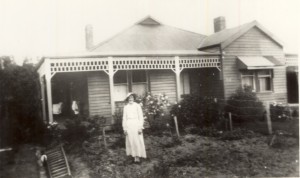
‘Glen Valley’ with lattice added to the veranda and the garden further developed.
HOUSE-WARMING. — Mr E Britton has built a spacious residence at Christmas Hills. On Easter Saturday night the residents wended their way to give Mr and Mrs Britton a house-warming. A very pleasant evening was spent and cheers were given for Mr and Mrs Britton. During the evening items were rendered by Mrs P Streets, Miss E Dunn, and Messrs S Rowe, O Murphy, T Hine, A Rowe, R Dunn, and E Rowe. Excellent music for the dancing was supplied by Mr Y Wilson. Mr P Streets very capably carried out the duties of MC.[1]
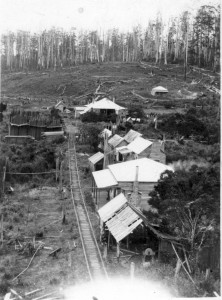
View from the chimney of the original sawmill, showing the blacksmith’s shop (foreground), workers’ cottages (middle distance) and the Britton family house (background). The tramway pictured was used to supply wood to the house. The Bass Highway would later separate ‘Manuka’ from the other buildings.
This was long before electricity or sewerage came to the bush. The toilet was a kerosene tin in a little hut behind the house. Once or twice a week the kerosene tin was emptied, the effluent being buried in a hole.[2]
The mill workers’ cottage vacated by Elijah’s family became Mark Britton’s quarters, where he slept and did the office work. Once a year Lorna washed his blankets and scrubbed his dirty floors. Mark was in the habit of piling bark, sticks and firewood against the inside wall of his office. ‘This was clean dirt, so I’d take that out and scrub that room, but the bedroom was the worst’.
‘Our home was his real home’, Lorna remembered. ‘He had his special place at the table and sat one side of the fireside of an evening in the lounge chair opposite Father all the years he lived with us’.[3]
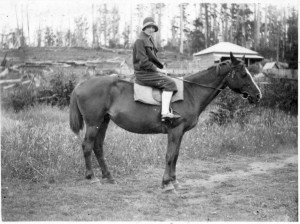
Lorna Britton leaving for a painting lesson on the ‘scary’ light chestnut draughthorse Boxer. She wrote that this horse was ‘so skittish he could toss me off his back easily, but boy could he trot. On the way to Smithton with the drains on each side of the Mowbray Swamp, it was a nightmare to have this scary horse. A passing car could make him jump sideways and you’d end up in the huge drain’. In the background is the cottage behind ‘Manuka’ which was used by workers at the mill, and in which Philip and Maria Britton also stayed.

An unusual shot of a middle-aged Annie Britton smiling.
Right from the start, Annie had recognised the need to diversify and, especially that farming, as well as timber, was needed to sustain her family. Her duties in the home were so many and so laborious that she was run off her feet. Even as her children were growing up and leaving home, Annie suffered with quinsy and a sore throat. She had her tonsils removed late in life in hope of fixing the latter problem. During the winters, her seasons of greatest suffering, the burden of the housework and childcare fell upon her eldest daughter Lorna:
Mother was either too sick or too busy to give the children much love, and I lavished all my affection on those kids. I never knew Mother to be affectionate to me or Phil, and we missed out there.
I was amazed to hear someone say they didn’t know I did anything other than play the violin and piano, paint, and be a lady. Maybe I did when they knew me, but who did the helping where there was no hot water and electric power and light? I would do the last tea dishes in a dish of hot water on the kitchen table by the light of one candle, and put away the meat that came late. It had to be lightly salted and put in the meat safe in a cool place. Mother would already be in bed, and I’d still be working till 8 or 9 o’clock.
Lorna remembered the young Ken as ‘The Little Comforter’ because with a twinkle in his eye he could bring a smile to Annie’s face
He loved the farm animals and could find a calf that had strayed or been hidden by its mother, or a hen’s nest. At that time the common swear word was ‘cussed’, heavily emphasised. I never heard my father, uncle or brothers swear, so Ken came running in at the lisping stage, clutching an egg and shouting ‘I heard a dusserd hen dackle, and I runned over and bruted her off the nest’. It was a favourite saying around the mill for a long time and caused many a happy moment.
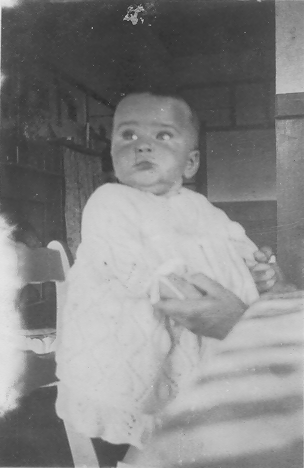
Ken Britton at six months of age in 1921.
The next-youngest boy John was ‘a frail little chap’ who developed eczema so badly that, despite medical treatment, Lorna feared his earlobes would drop off:
But he survived, and I cared for him until I was sent away to school in Launceston for one year. When I left school he was still weak and sickly, suffering many colds and Mother and I sat up more nights than I wish to remember when he had croup and we tried with limited medical care to ease his suffering.
One night he was so distressed that Mother, with her face set in anguish, left the room and brought in a spoonful of something which she poured down his little throat and soon brought relief. What it was I never really knew, but it was probably something that her mother had given her as a child. I think the mixture contained turpentine.
Both feared he would not ‘make old bones’, but John would prove them wrong.[4] Unfortunately, to do so, he would have to survive an accident in which his legs were crushed.

Lorna Britton at Broadland House, Launceston, 1923.
As Elijah and Annie’s children grew, the role of mail and meat bearers fell to Eva, Frank and Ken in turn. By that stage the house the Brittons formerly occupied at Christmas Hills had been enlarged to become the new school, and a public hall had also been raised nearby by public subscription. In 1922 the school graduated from a subsidised school to an ordinary state school, with Irene Dunn continuing as teacher.[5] It was in the unfinished school building that 15–year–old Lorna Britton was farewelled when she left for Launceston to finish her education at Broadland House Ladies’ College (now part of Launceston Church Grammar School):
Dancing was the order of the evening … a presentation of an Xylonite brush and comb and a very handsome box of writing material was made by Mr. C. Burton on behalf of the residents of Christmas Hills to Miss Britton to remind her of those she was leaving behind. Mr. Roy [sic: Phillip Raymond] Britton on behalf of his sister, thanked all for the kind wishes and the presents given to Lorna. The singing of “For she’s a jolly good fellow” terminated a very enjoyable evening.”[6]
[1] ‘Christmas Hills’, Circular Head Chronicle, 26 April 1922, p.3.
[2] Frank Britton memoir, 16 December 1992 (QVMAG).
[3] Lorna Britton notes1983.
[4] Lorna Britton notes 1983.
[5] ‘Xmas Hills Picnic Sports’, Advocate, 21 March 1923, p.6.
[6] ‘Christmas Hills: farewell’, Circular Head Chronicle, 14 February 1923, p.2.
by Nic Haygarth | 06/11/16 | Britton family history, Circular Head history
The dolomite swamp that took the name of the Brittons Swamp is thought to be a polje, that is, a centrally-draining dolomite sinkhole. Dismal Swamp, the selectively logged hollow now operated as a tourist venue, is an almost intact version of the same sort of feature.[1]
Beyond the basalt hills, on the dolomite swamp beyond, Mark Britton found huge stands of blackwood and saw a better future than he and his brother expected to get in the Mallee. He and Fred Oehm selected 200 acres each. Summoned over by his brother, Elijah selected 200 acres adjoining Fred’s block and which contained both hardwood and blackwood.
Phil Britton’s earliest memories of Tasmania were of arriving on the Holyman steamer the Marrawah at Burnie as a two-year-old. His sister Lorna was a babe in arms. From Burnie the family travelled by Tatlow’s horse-drawn coach south of the Sisters Hills and along the beach to Stanley, then changed coach to cross the old Sand Track over Tier Hill to Smithton.[2] Smithton had its own port at Pelican Point, from which timber was exported. Blackwood staves were already fetching a market on the mainland. On one occasion when Elijah and Harold braved the rough crossing on a timber ketch to Melbourne,
the skipper said, ‘If you blokes like to hop in and help load up these blackwood staves we will be away quicker.’ A certain Robert Pratt [junior] was also there and he did help. While Dad and Harold carried the staves on by the armful, R Pratt senior took one at a time. ‘For sure’, he said, ‘the pay will be the same’.[3]

(Left to right) Elijah, Mark and Harold Britton. Twenty-year-old
Harold Britton married nineteen-year-old Laura Fixter
in 1909 and moved to Leongatha, Victoria.

Christmas Hills State School, 1911, with five-year-old Phil Britton (arrowed) front row at left. The teacher pictured is probably Fred Parsons. The original school was a room provided by Tommy and Lizzie Hine, who also lodged the teacher and kept the post office. This was a ‘subsidised’ school, which relied upon the regular attendance of a set number of students and the community providing suitable lodgings for the teacher.
For two years the family lived in a cottage on a small acreage opposite the post office at Christmas Hills, with Elijah only coming home from the mill (four kilometres away) at weekends. While Harold Britton soon dipped out of the business, Mark and Elijah proved an ideal partnership. Elijah, a skilled, mostly self-taught blacksmith, filled the roles of engineer, saw doctor, stoker and timekeeper. He could repair anything mechanical, improvising as needed, and also manned the docker saw. Mark was a fine benchman, an expert at minimising wastage when cutting blackwood. His niece Lorna Haygarth (née Britton) recalled him even bemoaning the fate of heavy timber ends destined for the family fire:
Taking his pipe out of his mouth and putting it carefully on the hearth, he would declare, ‘What a waste, burning this beautiful wood. It should be kept and made into useful articles. Just look at the grain and lovely figure in this piece. It’s real timber, not like some of the pencil wood—it’s heavy, real heavy.’[4]
Mark was a good bullock and horse-driver and had the business brain, keeping the books. Above all, he was a positive thinker. This was essential, because the sight of a five–ton boiler being eased up the Sandhill to the Brittons Swamp site by a twelve–bullock team and a block and tackle signalled the start of a tremendous struggle for survival.

Building the Marrawah Tramway: bridging the Welcome River, 1913. From the Weekly Courier, 13 March 1913, p.20.
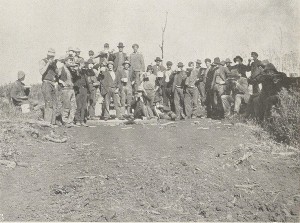
Free beer celebration for the construction party at Christmas. From the Weekly Courier, 13 March 1913, p.20
With government reluctant to build roads to bush selections, economic survival in almost impenetrable forest depended on sawmillers making their own path to market. The Marrawah Tramway (1912?–61) was started by JS Lee in order to harvest the timber on the Mowbray Swamp, epitomising the self-sufficiency and initiative of the early Circular Head sawmilling industry. The state government took over the tramway and extended it to Marrawah on the west coast. Then private timber tramways radiated from the Marrawah Tramway into the Montagu, Brittons, Arthur River and Welcome Swamps.[5]
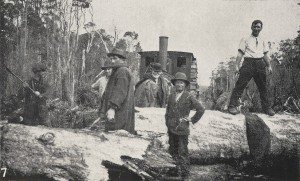
A blockage on the Marrawah Tramway. From the Weekly Courier, 13 October 1921, p.28.
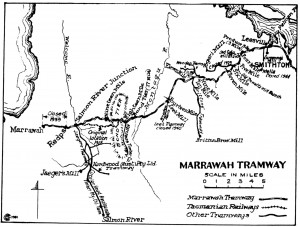
The Marrawah Tramway enters the dolomite Mowbray and Montagu Swamps on its journey from Smithton to Marrawah. Brittons’ branch tramway penetrates Brittons Swamp.
Map by ‘Wanderer’, ‘Railways and Tramways of the Circular
Head District’, Australian Railway Historical Bulletin no.168, October 1951.
Brittons’ line linked their mill to the 9¼-mile mark of the Marrawah Tramway. The 3’6”-gauge Britton Tramway cost about £2,000, a small fortune then. It originally used white myrtle spars for stringers, and was closely corded and ballasted with sawdust so that the five-horse team could haul the trucks of sawn timber (two at a time) without tripping. After a few years, heavy, long hardwood stringers were substituted for the white myrtle ones, and iron rails were placed on the outside bends. Twelve loading ramps enabled twenty-four loads of timber to be left at the junction with the Marrawah Tramway. The timber was then delivered to the Pelican Point jetty at the Duck River heads, where it was loaded on ships bound for Melbourne or Adelaide.[6]
Specialisation in blackwood, supplemented by production of hardwood and other timber, established the Britton’s seasonal regime. The swampy habitat of blackwood made haulage in the drier months essential, with strong, stoic bullocks being favoured for this task. (Horses were preferred to haul hardwood from the drier eucalypt forest.) Logging, cutting and carting in summer gave most of the men a job under cover, milling, in winter, when the weather was bad. In the winter of 1919, for example, Brittons milled about 8,000 super feet (24 cubic metres) of logs per day.
Loss of valuable horses to colic and falling trees prompted the purchase of a 1910 Buffalo and Pitts traction steam engine, which crushed culverts beneath it as it chugged from Forest to its new home. It was fuelled by the abundant wood and water. Elijah Britton devised a cog system which enabled the steam engine to be converted from road to rail, and the tramway was upgraded accordingly. The Buffalo and Pitts hauled sawn timber out to market on the tramway, back-loading with stores. When its boiler eventually rusted out, the engine was replaced by a 1904 Marshall single-cylinder traction engine, which had a better boiler and was a better steamer.
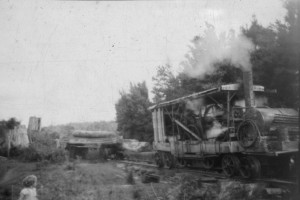
Bush engineering. The Marshall loco, seen here hauling a load of blackwood, was a triumph of improvisation.
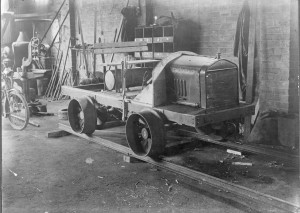
Brittons also had this Model T-Ford converted into a dynamic rail motor by Arthur Schmidt of Burnie.
Brittons’ transport problems didn’t end with delivery of timber to the Marrawah Tramway, as the following example illustrates. In 1918 Brittons reached an agreement with Cummings & Co to share the 20,000 super feet of space available on the Holyman steamer ss Hall Cain after JS Lee & Sons had loaded up their guaranteed shipment of 50,000 super feet. Brittons were to ship 15,000 super feet of hardwood to its agents in Melbourne, and delivered this timber to its junction on the Marrawah Tramway. However, timber was already stacked in the way at the junction, including seasoned blackwood owned by Cummings. This forced Brittons to load Cummings’ blackwood onto the vessel before they could load their own hardwood, leading to a dispute between the two companies. Brittons demanded and eventually gained compensation from Cummings.
[1] See Kevin Kiernan, An atlas of Tasmanian karst, Research report no.10, Tasmanian Forest Research Council Inc, Hobart, 1995.
[2] Phil Britton, ‘First Impressions of Brittons Swamp’; ‘The Britton Family’ (notes held by Britton family).
[3] Phil Britton, ‘First Impressions of Brittons Swamp’ (notes held by Britton family).
[4] Lorna Haygarth (nee Britton), ‘The Britton Story’ (notes held by the Britton family).
[5] ‘Wanderer’, ‘Railways and Tramways of the Circular Head District’, Australian Railway Historical Bulletin, no.168, October 1951, pp.151–52.
[6] Phil Britton, ‘The Britton Family’, pp.5–7 (notes held by Britton family).















